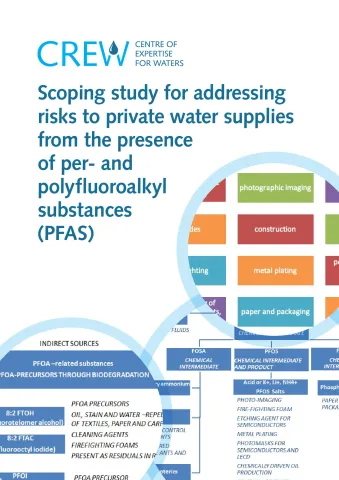In Scotland and the EU, drinking water quality is regulated under the Council Directive 98/83/EC on the quality of water intended for human consumption (Drinking Water Directive-DWD). The revision of Annex II Part C to the DWD in October 2015 focussed attention and limited resources to hazards of local concern, by requiring risk assessments at a supply zone scale as a basis for granting deviations from the list of parameters and frequencies subject to compliance monitoring. On the 1st of February 2018, the European Commission adopted a proposal for “recasting” the DWD to improve the quality of drinking water and provide greater access and information to citizens (EU Recommendation 2018). The proposal updates the list and standards (i.e. parametric values) of parameters to be monitored in line with latest recommendations of the World Health Organisation (WHO 2017).
The update includes chemicals, which are “new” to the Directive (EU Recommendation 2018), such as:
- Per- and polyfluoroalkyl substances (PFAS) as a group.
- Individual PFAS, e.g.: perfluorooctane sulfonic acid(PFOS), perfluorooctanoic acid (PFOA), perfluorobutane sulfonic acid (PFBS), perfluorohexane sulfonic acid (PFHxS), 8:2 flurotelomer alcohol (8:2 FTOH), 6:2 flurotelomer sulfonic acid (6:2 FTSA), perfluorobutyric acid (PFBA), perfluoropentanoic acid (PFPeA), perfluorohexanoic acid (PFHxA), perfluoroheptanoic acid (PFHpA), perfluorononanoic acid (PFNA), perfluorodecanoic acid (PFDA) and many more.
It is in this context that the present report was produced, addressing specifically the question:
Is there sufficient evidence for a high-level, national-scale assessment of the risk of detecting per- and polyfluoroalkyl substances (PFAS), such as perfluorooctane sulfonate (PFOS) and perfluorooctanic acid (PFOA), in private water supplies (PWS)?
This project developed and implemented a risk-mapping method based on GIS tools, a review of available evidence on types of direct PFAS sources (i.e. related to manufacturing and use) to the water environment in Scotland, the UK and internationally, and on available PFAS data in Scotland. We showed that there is sufficient evidence to identify the locations of the majority of types of potential direct PFAS sources (hereafter reported as Potential PFAS Source Sites) in relation to the locations of all PWS. However, there is not sufficient open-access PFAS data to identify PFAS risk to PWS, i.e. whether and where PFAS concentrations are above the limit of detection (LOD) in drinking water sources to PWS.
| Attachment | Size |
|---|---|
| CRW2017_12 Main Report | 1.78 MB |
| CRW2017_12 Appendices | 1.41 MB |
